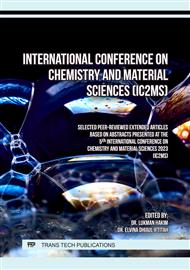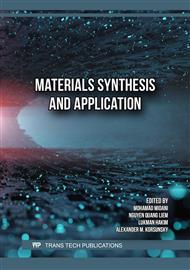[1]
IPCC, Climate change 2007: Mitigation of climate change - Contribution of working group III to the fourth assessment report. 2007.
DOI: 10.1017/cbo9781107415416.001
Google Scholar
[2]
J. Fu, P. Li, Y. Lin, H. Du, H. Liu, W. Zhu, and H. Ren, "Fight for carbon neutrality with stateof-the-art negative carbon emission technologies," Eco-Environment and Health, vol. 1, no. 4, pp.259-279, 2022.
DOI: 10.1016/j.eehl.2022.11.005
Google Scholar
[3]
P. Smith, "Soil carbon sequestration and biochar as negative emission technologies," Global Change Biology, vol. 22, no. 3, pp.1315-1324, 2016.
DOI: 10.1111/gcb.13178
Google Scholar
[4]
K. S. Lackner, S. Brennan, J. M. Matter, A. H. Park, A. Wright, and B. Van Der Zwaan, "The urgency of the development of CO 2 capture from ambient air," Proceedings of the National Academy of Sciences of the United States of America, vol. 109, no. 33, pp.13156-13162, 2012.
DOI: 10.1073/pnas.1108765109
Google Scholar
[5]
D. Moreira and J. C. Pires, "Atmospheric CO2 capture by algae: Negative carbon dioxide emission path," Bioresource Technology, vol. 215, no. 2016, pp.371-379, 2016.
DOI: 10.1016/j.biortech.2016.03.060
Google Scholar
[6]
B. D. Bhide, A. Voskericyan, and S. A. Stern, "Hybrid processes for the removal of acid gases from natural gas," Journal of Membrane Science, vol. 140, pp.27-49, 1998.
DOI: 10.1016/s0376-7388(97)00257-3
Google Scholar
[7]
H. Ababneh, A. AlNouss, I. A. Karimi, and S. A. Al-Muhtaseb, "Natural gas sweetening using an energy-efficient, state-of-the-art, solid-vapor separation process," Energies, vol. 15, 2022.
DOI: 10.3390/en15145286
Google Scholar
[8]
S. J. Chen, Y. Fu, Y. X. Huang, Z. C. Tao, and M. Zhu, "Experimental investigation of co2 separation by adsorption methods in natural gas purification," Applied Energy, vol. 179, pp.329-337, 2016.
DOI: 10.1016/j.apenergy.2016.06.146
Google Scholar
[9]
A. M. Yousef, W. M. El-Maghlany, Y. A. Eldrainy, and A. Attia, "New approach for biogas purification using cryogenic separation and distillation process for co2 capture," Energy, vol. 156, pp.328-351, 2018.
DOI: 10.1016/j.energy.2018.05.106
Google Scholar
[10]
A. A. Olajire, "Co2 capture and separation technologies for end-of-pipe applications - a review," Energy, vol. 35, pp.2610-2628, 2010.
DOI: 10.1016/j.energy.2010.02.030
Google Scholar
[11]
J. Gholinezhad, A. Chapoy, and B. Tohidi, "Separation and capture of carbon dioxide from co2/h2 syngas mixture using semi-clathrate hydrates," Chemical Engineering Research and Design, vol. 89, pp.1747-1751, 2011.
DOI: 10.1016/j.cherd.2011.03.008
Google Scholar
[12]
S. Horii and R. Ohmura, "Continuous separation of co2 from a h2 + co2 gas mixture using clathrate hydrate," Applied Energy, vol. 225, pp.78-84, 2018.[13] M. Ricaurte, C. Dicharry, X. Renaud, and J.-P. Torré, "Combination of surfactants and organic compounds for boosting co2 separation from natural gas by clathrate hydrate formation," Fuel, vol. 122, pp.206-217, 2014.
DOI: 10.1016/j.fuel.2014.01.025
Google Scholar
[14]
E. D. S. Jr and C. A. Koh, Clathrate Hydrates of Natural Gases. CRC press, 2007.
Google Scholar
[15]
B. Castellani, "Potential pathway for reliable long-term co2 storage as clathrate hydrates in marine environments," Energies, vol. 16, 2023.
DOI: 10.3390/en16062856
Google Scholar
[16]
J. Michl, M. Sega, and C. Dellago, "Phase stability of the ice xvii-based co2 chiral hydrate from molecular dynamics simulations," The Journal of Chemical Physics, vol. 151, p.104502, 9 2019.
DOI: 10.1063/1.5116540
Google Scholar
[17]
I. P. Pradana, D. Mardiana, and L. Hakim, "Carbon dioxide occupancies inside ice xvii structure from grand-canonical monte carlo simulation," IOP Conference Series: Materials Science and Engineering, vol. 833, p.012035, 5 2020.
DOI: 10.1088/1757-899x/833/1/012035
Google Scholar
[18]
D. M. Amos, M.-E. Donnelly, P. Teeratchanan, C. L. Bull, A. Falenty, W. F. Kuhs, A. Hermann, and J. S. Loveday, "A chiral gas-hydrate structure common to the carbon dioxide-water and hydrogen-water systems," The Journal of Physical Chemistry Letters, vol. 8, pp.4295-4299, 9 2017.
DOI: 10.1021/acs.jpclett.7b01787
Google Scholar
[19]
L. del Rosso, M. Celli, and L. Ulivi, "New porous water ice metastable at atmospheric pressure obtained by emptying a hydrogen-filled ice," Nature Communications, vol. 7, p.13394, 2016.
DOI: 10.1038/ncomms13394
Google Scholar
[20]
M. Matsumoto, T. Yagasaki, and H. Tanaka, "Formation of hot ice caused by carbon nanobrushes. ii. dependency on the radius of nanotubes," The Journal of Chemical Physics, vol. 154, p.094502, 3 2021.
DOI: 10.1063/5.0044300
Google Scholar
[21]
T. Yagasaki, M. Yamasaki, M. Matsumoto, and H. Tanaka, "Formation of hot ice caused by carbon nanobrushes," The Journal of Chemical Physics, vol. 151, p.064702, 8 2019.
DOI: 10.1063/1.5111843
Google Scholar
[22]
T. Matsui, M. Hirata, T. Yagasaki, M. Matsumoto, and H. Tanaka, "Communication: Hypothetical ultralow-density ice polymorphs," The Journal of Chemical Physics, vol. 147, p.91101, 2017.
DOI: 10.1063/1.4994757
Google Scholar
[23]
T. Matsui, T. Yagasaki, M. Matsumoto, and H. Tanaka, "Phase diagram of ice polymorphs under negative pressure considering the limits of mechanical stability," The Journal of Chemical Physics, vol. 150, p.41102, 2019.
DOI: 10.1063/1.5083021
Google Scholar
[24]
L. Hakim, K. Koga, and H. Tanaka, "Phase behavior of different forms of ice filled with hydrogen molecules," Physical Review Letters, vol. 104, p.115701, 3 2010.
DOI: 10.1103/physrevlett.104.115701
Google Scholar
[25]
L. Hakim, K. Koga, and H. Tanaka, "Novel neon-hydrate of cubic ice structure," Physica A: Statistical Mechanics and its Applications, vol. 389, pp.1834-1838, 5 2010.
DOI: 10.1016/j.physa.2009.12.021
Google Scholar
[26]
L. Hakim, K. Koga, and H. Tanaka, "Thermodynamic stability of hydrogen hydrates of ice ic and ii structures," Phys. Rev. B, vol. 82, p.144105, Oct 2010.
Google Scholar
[27]
L. Hakim, M. Matsumoto, K. Koga, and H. Tanaka, "Inclusion of neon inside ice ic and its influence to the ice structure," Journal of the Physical Society of Japan, vol. 81, p.18, 11 2012.
DOI: 10.1143/jpsjs.81sa.sa018
Google Scholar
[28]
M. Matsuo, Y. Takii, M. Matsumoto, and H. Tanaka, "On the occupancy of carbon dioxide clathrate hydrates: Grandcanonical monte carlo simulations," Journal of the Physical Society of Japan, vol. 81, p. SA027, 1 2012.
DOI: 10.1143/JPSJS.81SA.SA027
Google Scholar
[29]
U. Essmann, L. Perera, M. L. Berkowitz, T. Darden, H. Lee, and L. G. Pedersen, "A smooth particle mesh ewald method," The Journal of Chemical Physics, vol. 103, pp.8577-8593, 11 1995.[30] Z. Zhang and Z. Duan, "An optimized molecular potential for carbon dioxide," The Journal of Chemical Physics, vol. 122, p.214507, 6 2005.
DOI: 10.1063/1.470117
Google Scholar
[31]
J. L. F. Abascal and C. Vega, "A general purpose model for the condensed phases of water: Tip4p/2005," The Journal of Chemical Physics, vol. 123, p.234505, 12 2005.
DOI: 10.1063/1.2121687
Google Scholar
[32]
D.-M. DUH, D. HENDERSON, and R. L. ROWLEY, "Some effects of deviations from the lorentz-berthelot combining rules for mixtures of lennard-jones fluids," Molecular Physics, vol. 91, pp.1143-1147, 1997.
DOI: 10.1080/00268979709482801
Google Scholar
[33]
M. Matsumoto, T. Yagasaki, and H. Tanaka, "Genice: Hydrogen-disordered ice generator," Journal of Computational Chemistry, vol. 39, pp.61-64, 2018.
DOI: 10.1002/jcc.25077
Google Scholar
[34]
M. Matsumoto, T. Yagasaki, and H. Tanaka, "Novel algorithm to generate hydrogen-disordered ice structures," Journal of Chemical Information and Modeling, vol. 61, pp.2542-2546, 11 2021.
DOI: 10.1021/acs.jcim.1c00440
Google Scholar
[35]
J. D. Bernal and R. H. Fowler, "A theory of water and ionic solution, with particular reference to hydrogen and hydroxyl ions," The Journal of Chemical Physics, vol. 1, pp.515-548, 11 2004.
DOI: 10.1063/1.1749327
Google Scholar
[36]
M. Parrinello and A. Rahman, "Polymorphic transitions in single crystals: A new molecular dynamics method," Journal of Applied Physics, vol. 52, pp.7182-7190, 12 1981.
DOI: 10.1063/1.328693
Google Scholar
[37]
W. G. Hoover, "Canonical dynamics: Equilibrium phase-space distributions," Physical Review A, vol. 31, pp.1695-1697, 3 1985.
DOI: 10.1103/physreva.31.1695
Google Scholar
[38]
S. Nosé, "A unified formulation of the constant temperature molecular dynamics methods," The Journal of Chemical Physics, vol. 81, pp.511-519, 7 1984.
DOI: 10.1063/1.447334
Google Scholar
[39]
M. J. Abraham, T. Murtola, R. Schulz, S. Páll, J. C. Smith, B. Hess, and E. Lindahl, "Gromacs: High performance molecular simulations through multi-level parallelism from laptops to supercomputers," SoftwareX, vol. 1-2, pp.19-25, 2015.
DOI: 10.1016/j.softx.2015.06.001
Google Scholar
[40]
H. J. C. Berendsen, J. P. M. Postma, W. F. van Gunsteren, A. DiNola, and J. R. Haak, "Molecular dynamics with coupling to an external bath," The Journal of Chemical Physics, vol. 81, pp.3684-3690, 10 1984.
DOI: 10.1063/1.448118
Google Scholar
[41]
W. Lu, H. Guo, I. Chou, R. Burruss, and L. Li, "Determination of diffusion coefficients of carbon dioxide in water between 268 and 473k in a high-pressure capillary optical cell with in situ raman spectroscopic measurements," Geochimica et Cosmochimica Acta, vol. 115, pp.183-204, 2013.
DOI: 10.1016/j.gca.2013.04.010
Google Scholar



